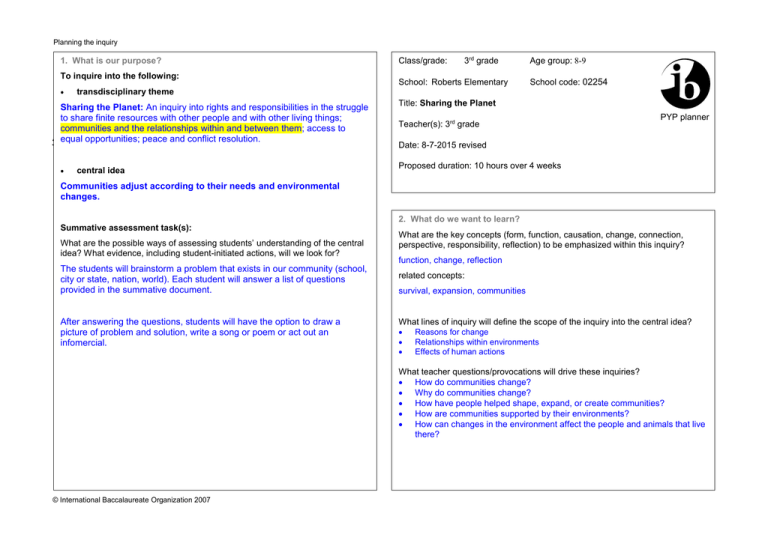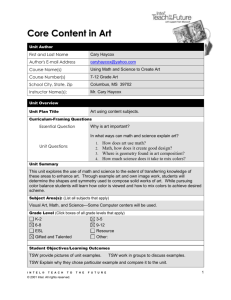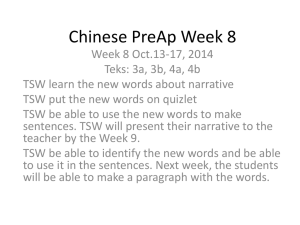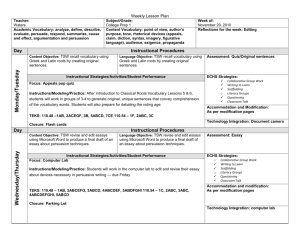PYP planner Planning the inquiry Class/grade: 3rd grade Age group
advertisement

Planning the inquiry 1. What is our purpose? To inquire into the following: 5 3rd grade School: Roberts Elementary Age group: 8-9 School code: 02254 transdisciplinary theme Sharing the Planet: An inquiry into rights and responsibilities in the struggle to share finite resources with other people and with other living things; communities and the relationships within and between them; access to equal opportunities; peace and conflict resolution. Class/grade: central idea Title: Sharing the Planet Teacher(s): 3rd grade PYP planner Date: 8-7-2015 revised Proposed duration: 10 hours over 4 weeks Communities adjust according to their needs and environmental changes. 2. What do we want to learn? Summative assessment task(s): What are the possible ways of assessing students’ understanding of the central idea? What evidence, including student-initiated actions, will we look for? The students will brainstorm a problem that exists in our community (school, city or state, nation, world). Each student will answer a list of questions provided in the summative document. After answering the questions, students will have the option to draw a picture of problem and solution, write a song or poem or act out an infomercial. What are the key concepts (form, function, causation, change, connection, perspective, responsibility, reflection) to be emphasized within this inquiry? function, change, reflection related concepts: survival, expansion, communities What lines of inquiry will define the scope of the inquiry into the central idea? Reasons for change Relationships within environments Effects of human actions What teacher questions/provocations will drive these inquiries? How do communities change? Why do communities change? How have people helped shape, expand, or create communities? How are communities supported by their environments? How can changes in the environment affect the people and animals that live there? © International Baccalaureate Organization 2007 Planning the inquiry 3. How might we know what we have learned? 4. How best might we learn? This column should be used in conjunction with “How best might we learn?” What are the learning experiences suggested by the teacher and/or students to encourage the students to engage with the inquiries and address the driving questions? What are the possible ways of assessing students’ prior knowledge and skills? What evidence will we look for? The class will dissect the Central Idea and write questions for the Wonder Wall. The class will complete a KWL chart about people who’ve shaped, expanded, or created communities. The class will complete a KWL chart about ecosystems and animal adaptations. What are the possible ways of assessing student learning in the context of the lines of inquiry? What evidence will we look for? TSW complete a four-square (foldable) that names and illustrates one individual, the problem they faced, their solution, and how they shaped, expanded, or created their community. TSW create an animal and describe its habitat, diet, and adaptations. Given scenarios, TSW create a cause and effect book that demonstrates the effects of human actions on the environment. Over the course of a week and a half, the students will be given the problems that Pierre L’Enfant, Benjamin Banneker, Benjamin Franklin, Daniel Boone, Christopher Columbus, the Founding Fathers, and Juan de Onate faced in their communities, and the students will propose solutions. After the students have proposed their solutions, they will compare their own solutions to what the person actually did. (SS TEKS 1A-C) TSW read about terrestrial and aquatic ecosystems and explain how the physical characteristics of the environments support life. TSW compare and contrast the two ecosystems. (Sci TEKS 9A) TSW create a food chain and explain what will happen if a piece of the food chain is removed (Interdependence of Plants and Animals activity). (Sci TEKS 9B) Given a food chain, habitat, or biome, the students will explain through writing and illustrations which organisms would thrive, perish, or move to a new location if there were a flood or drought. (Sci TEKS 9C) TSW learn about camouflage and how it helps survival through a yarn activity. (Sci TEKS 10A-B) TSW sort physical and behavioral animal adaptations. (Sci TEKS 10A-B) TSW listen to Ape and then compare how the different apes learn behaviors to survive and use tools to get food. (Sci TEKS 10A-B) After reading The Lorax, the class will discuss effects on the community after the Truffala trees were cut down. TSW look at a picture of a problem and come up with a way to solve (water pollution, noise pollution, air pollution, trash, traffic).T, RF, K TSW read The Little House and discuss before and after (how the community changed). R, SM, C, T; RF What opportunities will occur for transdisciplinary skills development and for the development of the attributes of the learner profile? Skills: R-research, T-thinking, Cm-communication, SM-self-management Learner Profile: B- balanced, P-principled, C-caring, RF-reflective, OM-open-minded, K-knowledgeable 5. What resources need to be gathered? What people, places, audio-visual materials, related literature, music, art, computer software, etc, will be available? BrainPop.com (Benjamin Franklin, air pollution, Christopher Columbus, camouflage, conserving energy, ecosystems, everglades, floods, food chains, fossil fuels, hibernation, honey bees, humans and the environment, migration, natural resources, natural selection, water pollution) BrainPopJr.com (Columbus Day, food chains, hibernation, camouflage, plant adaptations, forests, freshwater habitats, migration) The Lorax by Dr. Seuss; 50 things Kids Can Do; Great Kapok Tree, Ape United Streaming (Daniel Boone: Legends of Daniel Boone; Trash in the Environment) You Tube video: Trash Island How will the classroom environment, local environment, and/or the community be used to facilitate the inquiry? © International Baccalaureate Organization 2007 Reflecting on the inquiry 6. To what extent did we achieve our purpose? 7. To what extent did we include the elements of the PYP? Assess the outcome of the inquiry by providing evidence of students’ understanding of the central idea. The reflections of all teachers involved in the planning and teaching of the inquiry should be included. What were the learning experiences that enabled students to: How you could improve on the assessment task(s) so that you would have a more accurate picture of each student’s understanding of the central idea. develop an understanding of the concepts identified in “What do we want to learn?” demonstrate the learning and application of particular transdisciplinary skills? develop particular attributes of the learner profile and/or attitudes? In each case, explain your selection. What was the evidence that connections were made between the central idea and the transdisciplinary theme? © International Baccalaureate Organization 2007 Reflecting on the inquiry 8. What student-initiated inquiries arose from the learning? 9. Teacher notes Record a range of student-initiated inquiries and student questions and highlight any that were incorporated into the teaching and learning. Human effects are pollution, trash, scarcity, waste, conservation. What is currently in place for laws and policies How many trees do we kill with the paper we waste? Which state uses the most water? Why do we have factories if they cause so much pollution? Why doesn’t everyone care about the earth? Plug up your shower and measure water usage. Take a bath and compare the results. You should use less with a quick shower. What will happen when we run out of natural resources? Do a water usage survey at school. What kinds of future energy sources will there be? Influence family/friends/school/teachers community to make changes. How do my choices affect others? Announcements with Stephanie at end of day. Where does the trash go? Introduce the environmental labels, recycling symbols, Hunt for the Green, Trash game. See Louisa if you need information. At this point teachers should go back to box 2 “What do we want to learn?” and highlight the teacher questions/provocations that were most effective in driving the inquiries. What student-initiated actions arose from the learning? Record student-initiated actions taken by individuals or groups showing their ability to reflect, to choose and to act. Every student took action during this unit. The changes they made in their lives varied from conserving water to stopping the use of plastic grocery bags to recycling more at home and to recycling old electronics. © International Baccalaureate Organization 2007 Class action project-pick up trash, posters, maybe during lunchtime. Create a mural of action ideas for making our world a better place.





